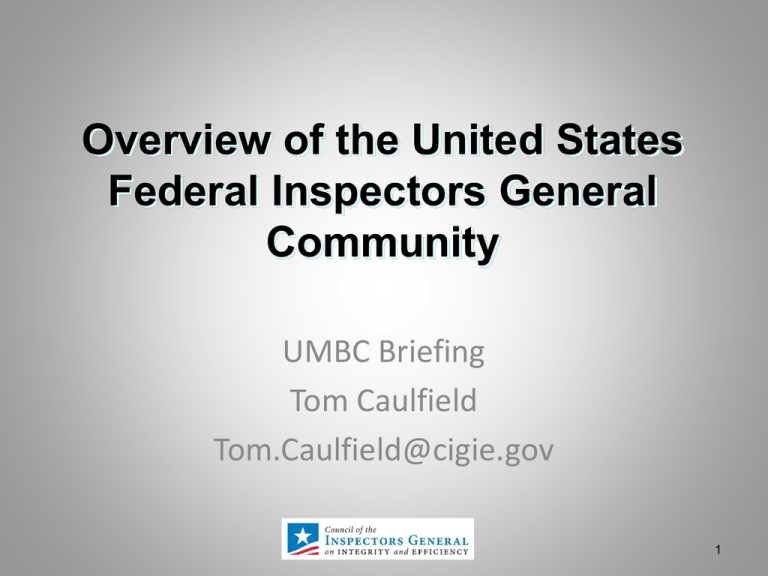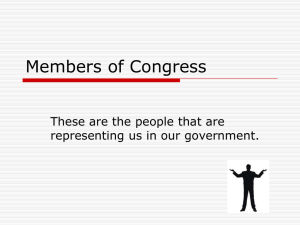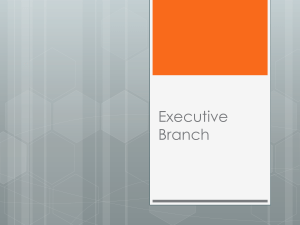Our IG Profession: Then and Now
advertisement

Overview of the United States Federal Inspectors General Community UMBC Briefing Tom Caulfield Tom.Caulfield@cigie.gov 1 IG Mission To promote economy, efficiency, effectiveness, and integrity in the delivery of United States Federal agency programs. 2 Key IG Activities AUDIT, INSPECT, and EVALUATE agency programs and activities INVESTIGATE allegations of wrongdoing REVIEW proposed legislation and regulations as to their likely effect on the economy and efficiency of the host department/agency INFORM agency head and Congress Operate a HOTLINE to receive information 3 What Does This Mean IGs provide Federal oversight to identify and recommend the elimination of fraud, waste, abuse, and mismanagement. IGs are a value added resource for the Executive and Legislative branches of the Federal government. 4 What IGs Do Not Do Operate Programs Create or Amend Program Policy Enforce Implementation of OIG Recommendations Suspension or Debarment Contractors Employment Decisions Regarding Agency Personnel 5 Hallmarks of an Effective IG Roles Oversight Independence Objectivity Responsibilities Identify Fraud, Waste, Abuse, and Mismanagement Dual Reporting Requirement (Department/Agency Head and Congress) Be Transparent to the Media and Public 6 Public Interface Hotlines IG Websites List Serves Semi-Annual Reports to Congress Freedom of Information Act 7 Council of the Inspectors General on Integrity and Efficiency (CIGIE) Established by Federal law: The Inspector General Act of 1978 IG Act Amendments of 1988 IG Reform Act of 2008 8 CIGIE Mission Address integrity, economy, and effectiveness issues that transcend individual Government agencies; and Increase the professionalism and effectiveness of personnel by developing policies, standards, and approaches to aid in the establishment of a well-trained and highly skilled workforce in the offices of the Inspectors General. 9 Membership and Construct of CIGIE 72 Federal Inspectors General (IGs) 6 Additional Members IG Staff Sizes Vary CIGIE Officers Integrity Committee and 6 Standing Committees 10 Federal IG Community: Results • FY 2010 – 6,784 audits and inspections – 25,589 investigations – 440,362 hotline complaints processed – Identified $87.2 billion in potential savings • FY 2011 – 7,469 audits and inspections – 26,677 investigations – 473,870 hotline complaints processed – Identified $93.9 billion in potential savings FY 2011 OIG community’s aggregate budget about $2.7 billion. Return of about $35 in potential savings for every $1 invested in OIGs. Our IG Profession: Then and Now Beginnings of the IG System in the U.S. • 1777 – George Washington is commander of the Continental Army • Army (est. in 1775) is new, loosely organized, and untrained • Oct. 1777 – GW meets with 14 of his officers and proposes idea of an Inspector General • Under GW’s proposal, IG is a “drillmaster general” • IG would promote tactical efficiency of the Army, report to Commander in Chief Beginnings of the IG System in the U.S. • Dec 1777 – Congress authorizes IG, but modifies GW’s proposal • Congress’ vision of an IG: – Less of a drillmaster, more of an inspector to review the troops, give understanding of unit’s condition – IG would largely be an agent of Congress, reporting to Congress Washington’s IG Report to Commander vs. Congress’ IG Report to Congress The question of whom the IG should report to is not easily answered. Beginnings of the IG System in the U.S. • Our Offices of Inspector General (OIGs) today: – Dual reporting report to agency head, also report to Congress – Independence The IG Concept Moves Into the Civilian side of the Federal Government IG Concept Moves into Fed Gov’t Let’s first define two terms: Administrative IG: Position created within an agency by the agency head. There is no law requiring an OIG to exist in that agency. Statutory IG: Position created within an agency by Congress. Congress has passed a law mandating (requiring) an OIG to exist in that agency. IG Concept Moves into Fed Gov’t – First Administrative IG “…established on 1 January 1952.” • Jan 1, 1952 – Stuart Hedden appointed IG of the CIA • Two things clear: – IG’s requests for info to be treated as requests from the Director himself – IG was responsible to Director, not other officers of the Agency (Acting as the Director’s “eyes and ears”) IG Concept Moves into Fed Gov’t – First Statutory IG • 1951 – Congress passed Mutual Security Act (authorized foreign aid) • 1959 – Act amended, created IG to oversee Int’l Cooperation Administration (ICA) (oversaw foreign aid operations) • New York Times article: position created “for keeping [ICA] free of waste, inefficiency, and corruption.” Landmark Legislation: Inspector General Act of 1978 (Pre) Landmark Legislation – Billie Sol Estes Scandal Billie Sol Estes • 1960s – USDA began controlling price of cotton, by specifying quotas and acreage allotments to farmers. • But if land had been taken by eminent domain, farmers could transfer their cotton allotment to another piece of land. • Estes persuaded farmers to transfer their cotton allotments to land in TX, and lease the land and allotments to Estes. • Estes was hoarding cotton allotments. (Pre) Landmark Legislation – Billie Sol Estes Investigations Congress launched exhaustive investigation; brought USDA’s subsidy programs under intense scrutiny: • “Estes’ misrepresentations succeeded primarily because of shortcomings in performance of the Department of Agriculture.” • “Agriculture personnel displayed a conspicuous lack of alertness.” • “Had the federal investigations been properly coordinated, it is almost inconceivable that Estes’ fraudulent activities could have been continued for such a long period.” (Pre) Landmark Legislation – Admin OIG Created at USDA Secretary of Agriculture Orville Freeman administratively creates USDA OIG in 1962. Secretary of Agriculture Earl Butz eliminates USDA OIG in 1974. USDA OIG Orville Freeman Earl Butz Landmark Legislation – Inspector General Act of 1978 The Inspector General Act of 1978 Signed by President Carter October 12, 1978 Created statutory IGs at: Department of Agriculture General Services Administration Department of Housing and Urban Development Community Service Administration Department of the Interior Environmental Protection Agency Department of Commerce Small Business Administration Department of Labor Veterans Administration Department of Transportation National Aeronautics and Space Administration Landmark Legislation – Inspector General Act of 1978 • Purposes of an OIG: Create independent and objective units to: √ Conduct and supervise audits and investigations relating to programs and operations of the agencies √ Promote economy, efficiency, and effectiveness in the administration of these agencies, and to prevent and detect fraud and abuse √ Provide a means for keeping the head of the establishment and Congress informed about problems and deficiencies Components of OIGs Components of most OIGs: • • • • • Audit Investigations Inspections & Evaluations Counsel Mission Support Creation of PCIE • 1981 – President Reagan signs executive order to create President’s Council on Integrity and Efficiency (PCIE) • Purpose – Forum for PAS IGs to meet together, enhance efforts to promote integrity and efficiency *Side note: IG concept began to move into state and local levels of gov’t at this time. Massachusetts created first state OIG in 1981. 1988 Amendments to IG Act • 1988 – Congress passed significant amendments to IG Act • Created statutory IGs at over 30 agencies (most smaller in size). Referred to as DFE OIGs: DFE: Designated Federal Entity IG is appointed by agency head • Only difference between PAS and DFE OIGs is the IG appointment type. Both are still statutory and operate independently from agency. Criteria of Becoming an IG According to IG Act (as amended): • Not appointed with regard to political affiliation • Appointed solely on basis of -integrity -demonstrated ability in accounting, auditing, financial analysis, law, management analysis, public administration, or investigations Creation of ECIE • 1992 – President Bush (Sr.) signs executive order to create Executive Council on Integrity and Efficiency (ECIE) • Purpose – Forum for DFE IGs to meet together, enhance efforts to promote integrity and efficiency PAS OIGs had PCIE - DFE OIGs had ECIE These two will later come together to form one Council… Establishment of Integrity Committee • 1996 – President Clinton signs executive order establishing Integrity Committee - Has members from both Councils (PCIE and ECIE) - Reviews allegations of wrongdoing committed by IGs/certain sr. staff of OIGs Statutory Law Enforcement Authority • 2002 – Passage of Homeland Security Act statutorily grants exercise of law enforcement authority to special agents of 24 OIGs. • Prior to this, few OIGs had law enforcement authority. • Attorney General released guidelines (on training, operational requirements, etc.) applicable to these special agents. IG Reform Act of 2008 and Creation of CIGIE IG Reform Act of 2008 Provided tweaks to IG authorities: • President or agency head must provide Congress a letter at least 30 days before removal or transfer of an IG • IG cannot receive a cash award/bonus • OIGs required to post reports (or portions) on website; direct link to hotline must appear on website • Integrity Committee was statutorily established (no longer just by executive order) • OIG required to obtain legal advice from its own counsel or another OIG’s counsel • Established Council of Inspectors General on Integrity and Efficiency (CIGIE) CIGIE Mission Under the IG Reform Act of 2008, PCIE and ECIE joined to form one Council CIGIE CIGIE’s mission is to: Address integrity, economy, and effectiveness issues that transcend individual government agencies Increase the professionalism and effectiveness of personnel by developing policies, standards, and approaches to aid in the establishment of a welltrained and highly skilled workforce in the offices of the Inspectors General CIGIE Structure Members: 72 Federal IGs 6 non-IG members -Controller, Office of Federal Financial Mgmt., OMB -Senior-level official from FBI -Director , Office of Government Ethics -Special Counsel, Office of Special Counsel -Deputy Director, OPM -Deputy Director for Management, OMB Full membership meets once per month Leadership: Phyllis Fong, IG USDA CIGIE Chair Lynne McFarland, IG FEC CIGIE Vice-chair CIGIE Structure, continued 7 Committees (and Current Chairs) • • • • • • • Audit (DODIG IG) Information Technology (Education IG) Inspection and Evaluation (HHS IG & Peace Corps IG) Investigations (Securities & Exchange Commission IG) Legislation (Small Business Administration IG) Professional Development (Interior Acting IG) Integrity (Senior-level official from FBI) Quality Standards • CIGIE maintains/updates the following: – Quality Standards for Investigators – Quality Standards for Inspection and Evaluation (aka The Blue Book) – Quality Standards for Digital Forensics – Quality Standards for Federal Offices of Inspector General (aka The Silver Book) • Quality Standard used by CIGIE, maintained by GAO: – Government Auditing Standards (aka The Yellow Book) CIGIE = The IG Community • OIG sizes – Large OIGs • DOD and HHS OIGs – about 1,700 employees each – Small OIGs • Denali Commission – 1 employee – And every size in between! • FY 2011 – approx. 14,700 employees in the Federal OIG community CIGIE is also a Federal Agency • CIGIE is also its own Federal agency w/ a small number of employees. • Coordinate bringing the IGs together and help to execute the community-cutting efforts – Mark Jones – Executive Director of CIGIE – Support staff to assist Mark (currently 3 people) – CIGIE Training Institute staff (currently 12 people) CIGIE Training Institute CIGIE Mission: Address integrity, economy, and effectiveness issues that transcend individual government agencies Increase the professionalism and effectiveness of personnel by developing policies, standards, and approaches to aid in the establishment of a well-trained and highly skilled workforce in the offices of the Inspectors General Est. 2011 – Tom Caulfield, Executive Director of CIGIE Training Institute CIGIE Training Institute CIGIE’s gateway to responsive, high quality, cost-effective, stateof-the-art, IG-specific training and professional development 1 Training Institute Audit, Inspection, & Evaluation Academy IG Criminal Investigator Academy Leadership & Mission Support Academy (AI&E) (IGCIA) (LMS) 3 Academies Our Unique Profession Unique characteristics that define our community: • Independence • Dual reporting • Preventive work Our IG Profession: Then and Now A network of professionals taking an independent look at the Federal government, holding it accountable through inquiry and oversight. Questions?










